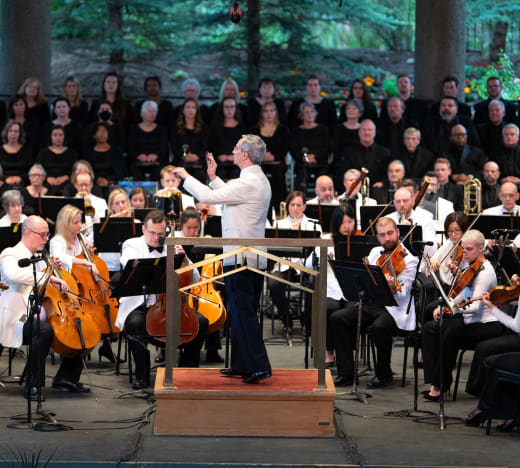
Tomas Cohen Photography
Haydn Cello Concerto
Dallas Symphony OrchestraLuisi leads the DSO in the first Bravo! Vail Symphonic Commissioning Project premiere—Angélica Negrón’s Arquitecta featuring Columbian-Canadian vocalist Lido Pimienta—in addition to the Bravo! Vail debut of cellist Jan Vogler in Haydn’s Cello Concerto in C major and Franck’s Symphony in D minor.
The Dallas Symphony Orchestra delivers uplifting, entertaining, and enriching musical experiences worldwide. This summer, the Orchestra returns to Bravo! Vail with a rich lineup that includes classical favorites and exciting pops programs.
All artists, programs, and pricing are subject to change.
Program Details
Fabio Luisi, conductor
Lido Pimienta, vocalist
Jan Vogler, cello
ANGÉLICA NEGRÓN Arquitecta (Vail Premiere of Co-Commission)
HAYDN Cello Concerto in C major
FRANCK Symphony in D minor
TALKBACK: Join Angélica Negrón and Anne-Marie McDermott in a talkback after the performance.
Guest Artists

Fabio Luisi

Lido Pimienta

Jan Vogler
Fabio Luisi
conductor
Fabio Luisi (conductor), a Grammy Award winner, began his tenure as Louise W. & Edmund J. Kahn Music Director of the Dallas Symphony Orchestra in 2020 and recently extended this contract through the 2028/29 season. In addition, he serves as Principal Conductor for both the Danish National and the NHK Symphony Orchestras. He previously served for six seasons as Principal Conductor of the Metropolitan Opera and nine seasons as General Music Director of the Zurich Opera. His 2022/23 season with the DSO included the release of Brahms’s First and Second Symphonies, available through the DSO’s in-house DSO Live label.

Lido Pimienta
vocalist
Lido Pimienta (vocalist) is a Grammy-nominated Columbian Canadian artist who is known for combining Afro and Indigenous musical traditions with a stylistic cumbia flair and electronica production. Her 2016 album, La Papessa, was the first independently produced non-English or French record to win Canada’s Polaris Music Prize. Her newest album, Miss Columbia, has been nominated for a Grammy Award, the Polaris Music Prize, and the Juno Award for Recording Package of the Year. In 2022 she completed an extensive tour which included performances throughout the US, Europe, Mexico, and Canada.

Jan Vogler
cello
Jan Vogler (cello) became the youngest player to serve as principal cellist of the Staatskapelle Dresden at age 20. He moved with his family to New York City in 1997, and in 2017 created, performed and recorded “New Worlds,” a music and literature project with friend Bill Murray. In demand worldwide, Vogler has premiered concertos by prominent composers and recorded 34 albums, including a Mozart Divertimento, recipient of Echo Klassik’s Chamber Music Recording of the Year Award. He is Artistic Director of the Dresden Music Festival. This is his Bravo! Vail debut.

Arquitecta (2022)
ANGÉLICA NEGRÓN (B. 1981)
SYMPHONIC COMMISSIONING PROJECT
Agraduate of the Conservatory of Music of Puerto Rico and New York University, where she earned her master’s degree, Angélica Negrón writes (as her website biography puts it) “music for accordions, robotic instruments, toys, and electronics as well as for chamber ensembles, orchestras, choir, and film.” A founding member of the tropical electronic band Balún, she was recently an artist-in-residence at The Greene Space in New York City, “working on El Living Room, a 4-part offbeat variety show and playful multimedia exploration of sound and story, of personal history and belonging.” Currently a teaching artist for the New York Philharmonic’s Very Young Composers program, she wrote You Are the Prelude (for orchestra with chorus) on commission from the New York Philharmonic for festivities surrounding the opening of its redesigned concert hall last fall, a work “honoring the wider community of listeners and the transformative act of gathering together and communing around art and music.”
Arquitecta, for orchestra with the Colombian Canadian singer Lido Pimienta, sets a poem by the Puerto Rican poet Amanda Hernández. Says Hernández: “I wrote this poem thinking about the house I grew up in, the houses I have lived in and the houses I had to say goodbye to. It’s an ode to the pain that comes with farewell and the celebration of what that ‘new door that opens’ promises when another one closes, or collapses.” In this poem, Negrón writes, “Hernández captures the maternal spirit and its connection to tangible spaces often burdened by a lifetime of memories and labor, both visible and invisible. The physical and emotional weight of caring for family and home transcends the passage of time and endures beyond loss.” Negrón found this particularly resonant in light of her own grandmother’s death and the caregiving her final years entailed.
Cello Concerto in C major, Hob. VIIb:1 (ca. 1765)
FRANZ JOSEPH HAYDN (1732-1809)
Cello Concerto in C major
Moderato
Adagio
Finale: Allegro molto
Franz Joseph Haydn’s Cello Concerto in C major, today one his most popular concertos, lay in oblivion for nearly two centuries. Haydn entered it into the catalogue of compositions he began around 1765, so he must have written it by that year at the latest. It was therefore a work of the composer’s first years at the court of the Esterházy Princes. The star cellist there was Joseph Franz Weigl, whom Haydn also spotlighted through passages for solo cello in a number of his early symphonies. Weigl probably kept this concerto in his repertoire, but it was not published. At some point a copyist’s manuscript parts landed in the library of the Counts Kolovrat-Krakovský at Radenín Castle in what is now Czechia. Their collection was deposited in the National Museum of Prague and through the grace of the Muses made it through World War II. The parts were uncovered there by musicologist Oldřich Pulkert in 1961, at which point the concerto finally entered the pantheon of cello masterpieces.
The first movement unrolls at a spacious pace, without calling undue attention to the considerable virtuosity required for its execution. Pairs of oboes and horns add body to the tutti sections, though Haydn limits the accompaniment to a string orchestra when the cello is playing, to keep the texture light. Indeed, the winds remain silent throughout the elegant second movement. The finale is a veritable tour de force. Following the opening tutti, the cello dazzles with quick scales that erupt out of notes sustained over several measures. Rapid-fire arpeggios, unrelenting scales, quickly repeated notes, and high-lying passage-work push the soloist into virtuosic territory.
Intermission
Symphony in D minor (1886-88)
CÉSAR FRANCK (1822-90)
Symphony in D minor
Lento: Allegro non troppo
Allegretto
Allegro non troppo
Most of César Franck’s major works were created in his final decade, so he was both an early bloomer and a late bloomer. He was a child prodigy who failed to gain traction as “a second Mozart,” which prodigies or their promoters (like Franck’s father) always hoped to do. Following study at the Paris Conservatoire, he found stability through a series of appointments as a church organist in Paris, most enduringly at the Basilica of Ste. Clotilde, where he served from 1858 until his death. In 1872 he succeeded his own former teacher, François Benoist, as organ professor at the Conservatoire, where his seminars served as the de facto training ground for an entire generation of France’s leading lights.
His symphony, composed from 1886 through 1888, is his only effort in the genre. It stands within the tradition of the 19th-century symphony, and yet its place is a bit to the side of the mainstream. Wagnerism was a hot topic in Paris when this work was born, and it clearly cast a spell over Franck. But one senses that Franck’s Wagner arrived filtered through Liszt, the composer to whom Franck bears the most striking resemblance. In describing Franck’s particular sound, one should not overlook that he was first and foremost an organist. As an orchestrator, his point of departure was always organ registration, and it is often tempting to imagine his symphonic scores as translations of sounds he himself might have produced in the organ loft. Even the architecture of his music is grounded in organ-playing, which in his time— and to some extent still today—exalts the art of improvisation, for which such quintessentially Franckian traits as brief fugato passages, cyclic development of themes, and highly chromatic modulation serve as fundamental techniques.
Did you know?
The Dallas Symphony Orchestra delivers uplifting, entertaining, and enriching musical experiences worldwide. This summer, the Orchestra returns to Bravo! Vail for its 21st summer residency with a rich lineup that includes classical favorites and exciting pops programs
All artists, programs, and pricing are subject to change.
